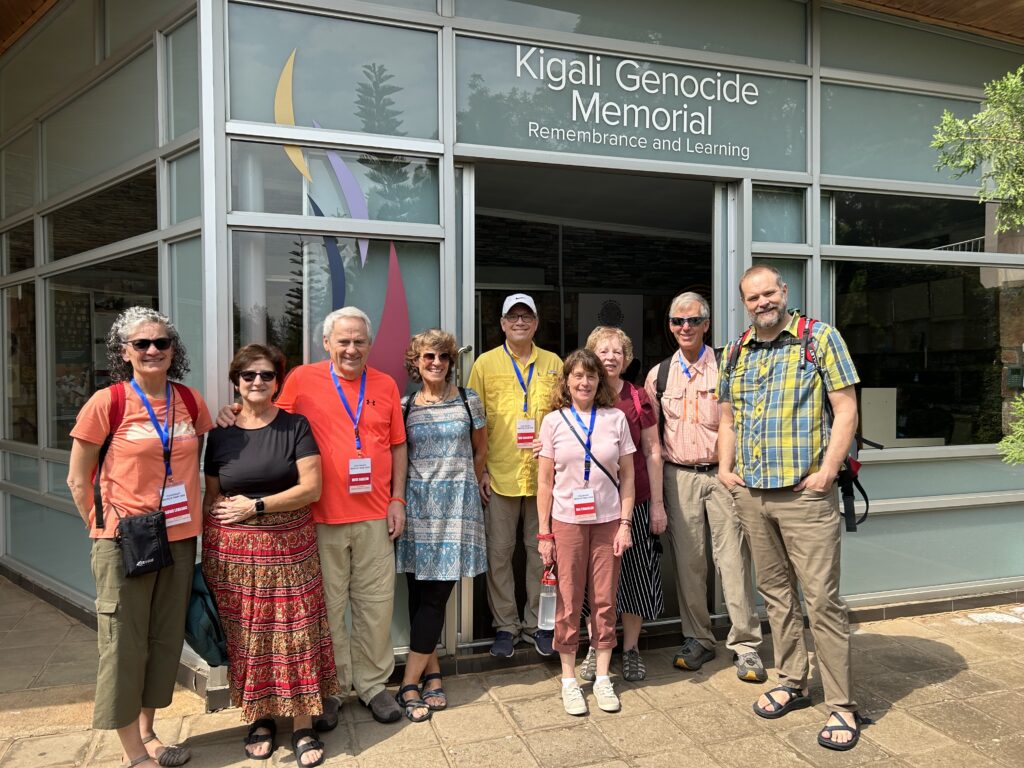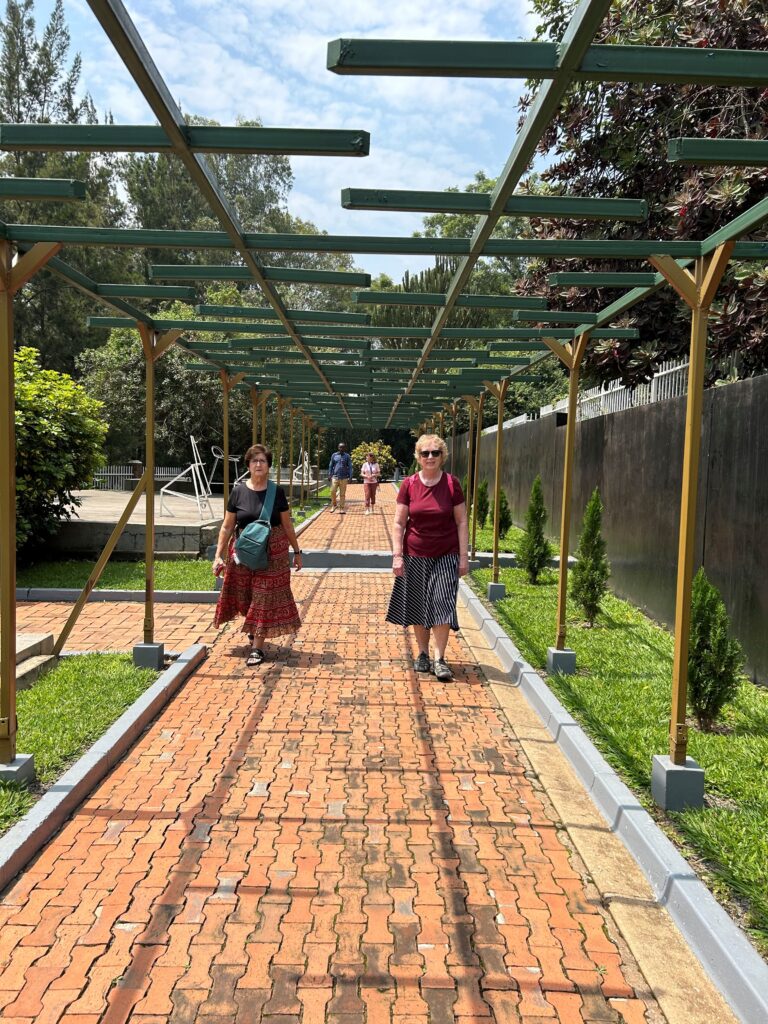Morning Day 1
~ by Win Brandon ~
After a long journey, morning seemed to arrive too soon on our first full day in Kigali, Rwanda. Awakening at various times, to roosters crowing and occasional dogs barking, we made our way downstairs to the Solace Guest House lobby and Solace Restaurant. It was our first view of Kigali in the daylight and morning dawned clear and sunny in the mid – 60’s. We were treated to a delicious buffet breakfast, starting with a big pot of coffee, which most of us needed after a variety of results on our first night’s sleep. We took our breakfast on the open veranda section of the restaurant and enjoyed the cool, humid morning and pretty views of the surrounding hillside and parts of the city.
After breakfast, our team of thirteen gathered for the morning devotional, led ably by Peggy Karg, then reviewed our Day 1 agenda. Six members were on return visits to Rwanda while seven of us were experiencing our first trip. Our day was to be divided into two segments, a morning session – featuring a trip to the Rwanda Genocide Museum (RGM), and an afternoon session – featuring a trip to the Nduba satellite LWA facility. Sally and Deb ran errands, including currency exchange, and organized our next few days in Kigali visiting the “Love With Action” ministry, while most of the rest of the group traveled to the RGM for a bit of Rwandan history, albeit a sad and terribly period in Rwanda, the effect of which no doubt be felt generations to come.
On the morning of April 7, 1994, a government trained militia, the Interahamwe-translated as “those who attack together”, comprised mostly of members of the Hutu ethnic majority in Rwanda, initiated an incredibly brutal attack on the Tutsi ethnic minority group, resulting in the death of as many as 800,000 – 1,000,000 people. The genocide spread with shocking speed and brutality, primarily because ordinary [Hutu] citizens were incited by local Hutu Power government officials to take up arms against their Tutsi neighbors. By the time the Tutsi-led Rwandese Patriotic Front gained control of the country through a military offensive in early July (only 3 months later), hundreds of thousands of Rwandans were dead and 2 million refugees (mainly Hutus) fled Rwanda, exacerbating what had already become a full-blown humanitarian crisis.
The museum was erected to help the country heal and to remember the victims of this terrible stain on Rwandan (and human) history. The museum is educational but incredibly sobering. We watched a 7 minute video introducing the museum including testimony from survivors of the genocide, then toured the various exhibits in the museum. Numerous pictures, videos, and posters along a winding hallway constitute one exhibit; a second is comprised of 3 separate displays of skulls and bones (possibly leg bones) from the victims; the third is a room with literally hundreds of individual pictures of victims in displays from the floor to the ceiling; a fourth (and quite possibly the saddest) is a children’s exhibit, consisting of a series of full size posters of various child victims with demographic information for each including, the name, age, favorite food and drink, last words uttered by the child and cause of death. I was moved to tears several times during my visit, as were others I noted as a toured. The sheer brutality and the violation of trust among neighbors and “friends” during the genocide are truly hard to comprehend and during an 80 minute tour inside, I never once heard another visitor utter a spoken word. So many of the video interviews during the tour highlighted the difficulty the survivors of the genocide have in ever being able to trust anyone again, including relatives, and so the healing continues almost 30 years later.
While the museum is surrounded by beautiful gardens with walking paths winding throughout and several large concrete pavilions, it is estimated that the site is the grave of 250,000 of the victims. It is difficult to comprehend how “hate” can drive humans to be so cruel and reminds us of the overwhelming need for people to find a way to co-exist, to solve problems without bloodshed, and treat each other with kindness, respect and love, not violence. After touring the memorial, it is evident that recovery from the genocide will take generations of forgiveness, love and acceptance. The tour truly reinforced, by contrast, the value and joy which is created by the “Love with Action” and “Shalom” ministries we have come to serve here in Rwanda. Pray that the healing continues, that the victims can learn to trust again, and that a loving and compassionate God and his grace will encourage and sustain the people of Rwanda as they heal and recover.
The ride back to our guest house was solemn and we each reflected on the tour and how it personally impacted each of us.



13 responses to “Rwanda Genocide Museum”
You are looking good. Continued prayers the God would be with you every step of every day.
Everyone is lookin good. Prayers for God to continue to walk with you.
Win, you did a marvelous job capturing the tour of the memorial and the impact on you all and the similar brutality that has gone on since and before. I went on the tour twice and your post brought it back to me once again. Thank you, Jim Stuart
Wow! Thank you for this well written account. 🙏
Thank you so much Win for the update. Terry & I saw 2 of the videos about the genocide. My how sad neighbors and friends could turn against one another all due to lies. We are excited to hear from you. Julie and I are getting a group of the St. James spouses & those who had hoped to join the mission together sharing a meal as you are sharing the banquet with the LWA families. We will be praying for LWA, the Shalom groups and all on the mission. Blessings to you all and we’ll look forward to hearing all about the mission soon. Blessings Terry and Charlotte 🙏🙂🙏
I have been there, and it is truly a heartbreaking place to visit.
I’m glad the museum is there as a tribute to the victims and as a solemn reminder that this can happen again and, in fact, is happening in the Middle East right now. Sending fortifying prayers for the days ahead. May you see many things that give us hope and make us rejoice!
Thank you for such a vivid description of the Rwanda Genocide Museum. Truly a terrible time in Rwanda’s history. Prayers for the victims and their continued healing. Prayers for all of you and the heavy hearts you must have after such an emotional visit. ❤️🙏
Very enlightening description of the Rwanda Genocide Museum. Amazing what hate generates. Prayers to all!
Thank you for this wonderful perspective . I remember very well the feelings I had being at the memorial and thank you for the reminder to all of us both in and out of the faith community to focus on love kindness and gentleness with each other no matter what our tribal background , our color , our faith denomination or our political views. What happened in Rwanda could happen anywhere if we don’t focus on the love God has offered us and filled us with. Thank you to all on the team for sharing that love with the people you are meeting in Rwanda. Blessings kate
Nothing can substitute for seeing the memorial in person, but you described it so well. The details brought it home. Thinking of the last words of a child is so sad. Thank you, Win.
I can’t begin to imagine the pain, suffering and huge loss experienced by so many of the Rwanda people. I pray that this hatred would never attack Rwanda again, or any other community, for that matter. Although someone early posted that this hatred continues today. Yes, our world needs to know our God who is faithful, loving and full of grace. I’m thankful the LWA team teaches God’s love to their needy people. Thank you to all the Rwanda team there today and those yet to come.
Thank you Win for your account of the visit. I found it very sobering to visit the memorial myself. It helped me to better understand the pain and suffering of the Rwandans and helped me in my interactions with the people. May you be blessed by having this experience.